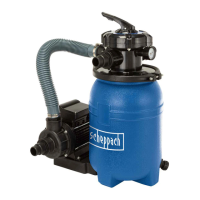www.scheppach.com
26
|
GB
10.4 Connecting the pool lter system to the pool
1. Connect the suction connection (8) of the pump to
the pool using a hose (not included in the scope
of delivery).
2. The return outlet (16) must also be connected to
the inlet nozzle at the edge of the pool.
3. Connect the disposal connection (2) to the drain.
NOTE!
Risk of damage!
Operating the pool lter system with too little or no wa-
ter can cause damage.
- Never allow the pool lter system to run dry.
10.5 Filling the lter pump with water (g. 10)
1. Loosen the hose (14) of the pressure connection
(12).
2. Fill the lter pump (11) with a sucient amount of
water.
3. Put the hose back on and fasten it with a hose
clamp (13).
11. Start up
m Attention!
Always make sure the device is fully assembled
before commissioning!
NOTE!
Risk of damage!
Operating the pool lter system with too little or no wa-
ter can cause damage.
- Never allow the pool lter system to run dry.
11.1. Function of the 5-way multi-valve (1) (g. 11)
Important: Disconnect the pool lter system from
the mains rst before actuating the valve lever!
11.1.1 Filtering
The water taken from the pool passes through the lter
medium from top to bottom and is thus cleaned.
1. Set the 5-way multi-valve (1) to FILTER. The lter
is now ready for mechanical water treatment of
your swimming pool.
2. In order to be able to determine the time point of
the BACKWASH lter cleaning, the pressure can
be read on the manometer (29). If the pressure in-
creases to 0.3 bar (max. 0.68 bar), backwashing
must be carried out. It is advisable to backwash at
weekly intervals, even if this value is not reached,
so that the lter sand remains loose.
10.2. Filling the pool lter system (g. 5, 6 and 7)
IMPORTANT:Only use quartz sand (not included in the
scope of delivery) with a grain size of 0.45 - 0.55 mm.
Note the exact grain specication. If the grain size is
too small, it can cause sand to be ushed into the pool.
If the grain size is too large, it diminishes the quality
of the lter.
Alternatively, you can use lter balls for lling the lter
tank (5) (not included in the scope of delivery).
Please consider:Before the lter tank (5) is lled with a
lter medium, make sure that the lter pipe (17) and the
lling aid (18) are in the lter tank (5).
1. Place the lter pipe (17) in the centre of the lter
tank (5). The lling aid (18) is used to x the lter
pipe (17) in position and lock it in place. It also pre-
vents the lter medium getting into the lter pipe
(17) while lling (see Fig. 6).
2. Fill the lter tank (5) with the lter medium and en-
sure that no lter medium gets into the lter pipe
(17).
3. The height of the content should not exceed 2/3
of the total height of the lter tank (5). This cor-
responds to approximately 10 kg quartz sand or
300 grams of lter balls. Note:Top up with water
occasionally so that the lter medium binds.
4. After the lter tank (5) has been lled, the lling aid
(18) can be removed again. Save them for future
relling - such as when changing sand.
5. Make sure that the lter tank seal is clean. The
fringe of the lter tank or that of the 5-way mul-
ti-valve (1) against which the seal rests must also
be clean and free of any grains of sand. The lter
pipe (17), which sits in the container, must be in-
serted in the middle and fully into the 5-way mul-
ti-valve (1).
6. Now place the 5-way multi-valve (1) incl. O-ring (4)
onto the lter pipe (17) and attach it to the lter tank
(5) using the clamping ring (3). (See g. 7)
10.3 Connect lter tank to lter pump (g. 8 + 9)
Now connect the lter pump (11) and the 5-way valve
(1) to the hose (14).
1. Fit the hose clamps (13) to the hose.
2. Connect the hose (14) to the lter inlet (15) on the
lter tank and to the pressure connection (12) on
the pump.
3. Tighten the screws on the hose clamps (13).

